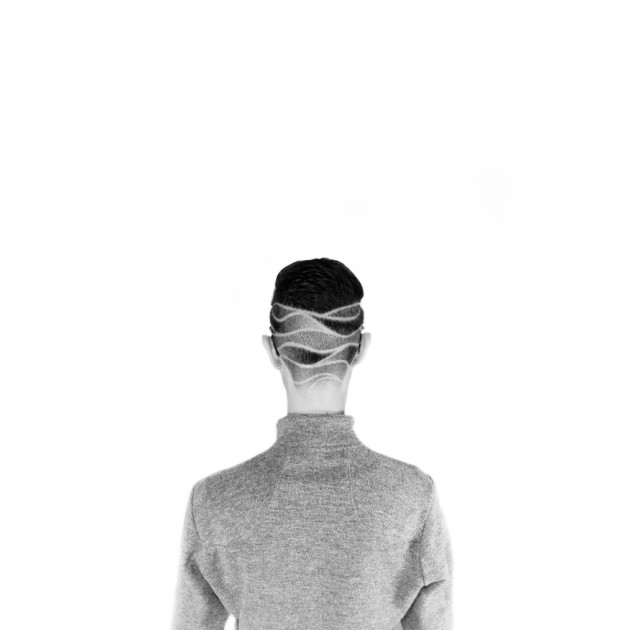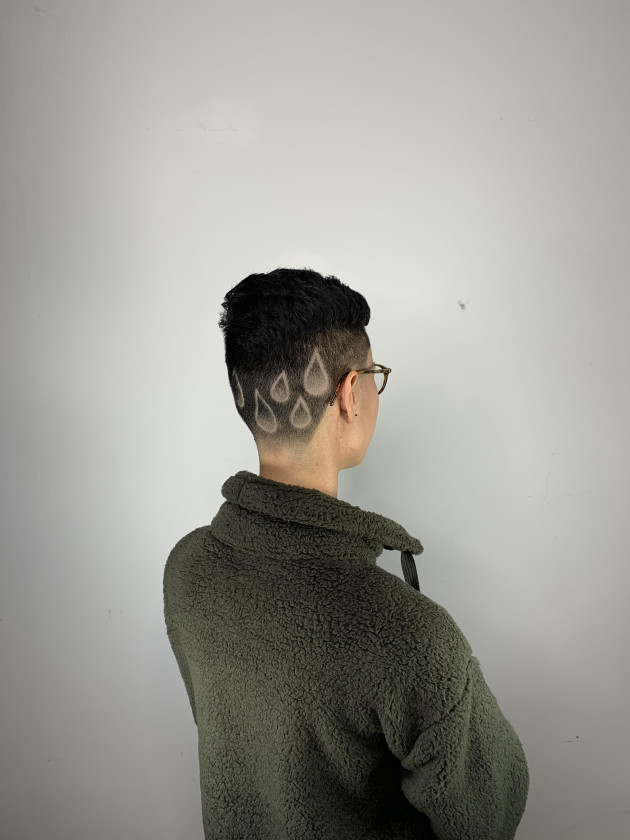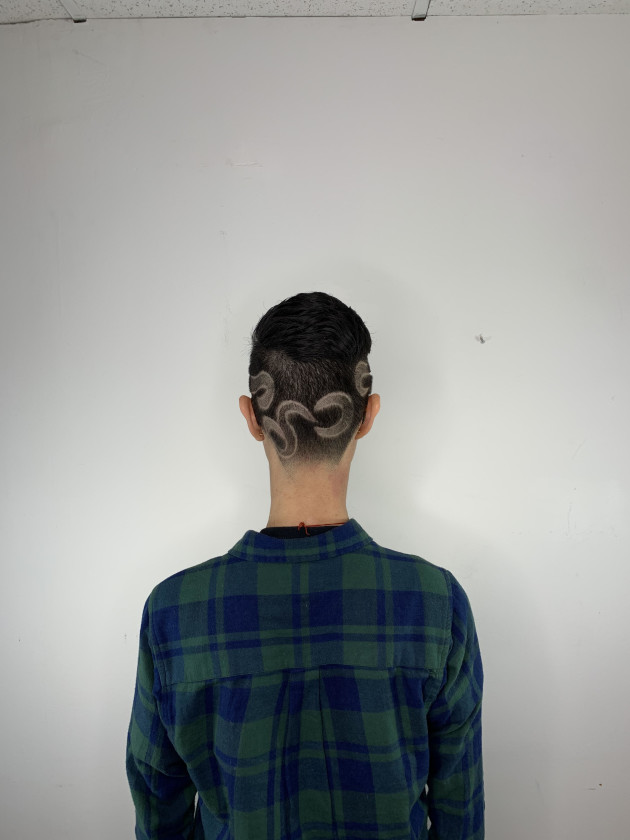Tag : hair
January 26, 2021 by admin
My Covid Curls
I got sick in mid-March. By the time I regained any semblance of mental focus or lung capacity it was near the end of May. I Marie Kondo-ed every cabinet and surface of the house. In the interim, the world was on lockdown, my roots were growing in, I hadn’t had my monthly haircut since February, hadn’t had one of the blowouts I had slavishly scheduled for so long, and frankly, nobody—least of all myself—could give a shit! My daughters, son and husband had stylists come to the driveway to cut their hair before Passover and the omer. I decided to abstain.
Pesach, the omer, Shavuot, each came and went. My hair grew longer. My megawatt blow-dryer and flat iron remained in the bathroom cabinet. Hair salons reopened. My hair grew. I started to read about care for curly hair. Black Lives Matter pierced the national consciousness and my own. As with every Martin Luther King Day, Jews of Color came to the foreground of my consciousness as a Persian Jew and president of a Mizrahi nonprofit. I started to embrace my curls as part and parcel of my core identities. Maybe my curls mean Persian Mizrahi Jew. Maybe they mean I finally break from the conformity of all the years I
tried to “pass,” whatever that even means. Maybe my curls and waves mean I am tired of spending so much time guarding my hair from the elements and worrying about frizz.
I know that my bucking hair conformity is not earthshattering. And, yeah, I know well just how it sounds to write about hair in the middle of a pandemic and at the onset the new year. I’m self-aware, I promise. In the meantime, I am grateful to have myself back, my hair flowing loosely, God-willing, into my sixth decade and beyond.
—
REBECCA SASSOUNI, “I Had Planned a Midlife Hair Makeover — Then Covid Showed Up,” Lilith Blog, October, 2020.
- No Comments
October 23, 2020 by admin
Why My Hair Falls the Way it Does •
I will remember the outline of the Blue Mountains in the town where my father grew up in Jamaica. I will remember the old siddur books in my grandfather’s shul that had been held by generations before me. But I will also remember the harder times.
I remember the smell of the cream that would strip my curls, and make it easier for
me to attend my Jewish day school without feeling different. But that was then. Now I walk through the halls of my high school with my curls coiled and alive.
At the age of 17, it has become easier to let these two parts of my identity—Jamaican and Jewish—become one. Memories from my childhood, good and bad, have helped shape my understanding of who I am and why my hair falls the way it does.
MAKEDA ZABOT-HALL on the Lilith Blog
- No Comments
October 7, 2020 by Rebecca Sassouni
I Had Planned a Midlife Hair Makeover— Then Covid Showed Up
Dear Reader,
In the midst of a terrible season, allow me some self-indulgence.
During the winter of 2020 before the world derailed with Covid-19, I was 49 years old, facing my 50th birthday with a mix of excitement and resignation. Certainly, I was glad to be healthy, in an intact marriage, with growing wonderful children, and a full roster of friends, family, social engagements, community service, and even a resuscitated second act after retirement to practicing as an attorney in solo practice.
- 1 Comment
September 9, 2020 by admin
My Hair as a Metaphor
I lived trying to fit in. It was much more than “curly hair wasn’t in style back then.” It was: “You can’t exist.” It was: “Do not exist.” It was expressed as: “What’s wrong with your hair?” with the questioner trying not to laugh when asking.
My hair was a problem to be solved. From inside and outside the walls of my house, my hair was a symbol of something larger that had nothing and everything to do with me.
- No Comments
May 4, 2020 by admin
My Version of a Kippah
It was the day after my wedding, and I was annoyed. Now that I was married I was trying to cover my hair, but the scarf kept slipping off my head. I folded and refolded the cloth, and tried to tie it as tightly as possible.
My brand-new husband and I were still in the hotel room in Williamsburg, Brooklyn, where we had spent the night after our wedding. The previous day had been the best of my life. Joy, crying, singing, dancing, an after party on a rooftop, and now – well, now I was folding and refolding a goddamn scarf. Why was I doing this?
- No Comments
April 20, 2020 by admin
I’m Eleven and I’ve Lost My Hair
For the last five years I have worn my hair long, thick and wavy, half-way down my back. I put it in ponytails, or I wear it down, or I bundle it in a bun. I just turned 11.
But, I recently discovered I have liver cancer. Which was a real pain for me, because I have never had anything like that before. I knew I would lose my hair. A couple weeks after starting chemo, it began: first a little bit, mostly in the shower; then losing big, big chunks of hair.
Quickly, it got to be just too much. So I ended up going to a barber in my town. (My parents called in advance, and they told us we could come after closing time, without others in the shop.)
The barber was a woman named Rosa. When I got there she said she would cut off my ponytail, which was big for me because I haven’t had my hair that short in a very long time. But I let her do it without a second thought. Soon enough, I had hair as short as I had when I was 5, when I had a bob. I hated that bob.
Then she began buzzing my head. I thought, “Would I look the same? Would I look different? Would I recognize myself ?”
I was turned away from the mirror so I didn’t see what was going on. But my mom did. She kept taking pictures. And she looked very happy, so that was encouraging. When the barber was done,
I looked at myself. It was very strange. I couldn’t get used to it.
When she was finished, she washed my head, like I had always done at all my hair cuts, just like it was a trim, or a little cut.
But it wasn’t. It was full on bald. With a little bit of buzz.
In the morning when I woke up I went into the bathroom and looked in the mirror. I took a picture and I thought, “Will I ever get used to it?” My friends said it was cool. My friends said I was brave. (My dad had said that too, but he was already bald.)
Most girls at school have long hair and put it back in ponytails like I always did. Of course, I haven’t gone to school for awhile. My sister, Hana, who is 6, still has long hair. Long curly hair. As I feel her hair, I can still feel my own. But it was very exciting for Hana to brush the tiny hairs on my head back and forth because she thought it was like a big fuzz ball. Which it is.
Once I went back to the hospital for chemotherapy, I noticed all the other people with cancer, who had let their hair thin out or shaved it like I had. And I knew I didn’t look that different from them. But I didn’t feel the same as them. I didn’t want to go through the same thing. I didn’t think it was fair.
What wasn’t fair? I don’t know. Everything. Losing my hair. Cancer.
But I’m comfortable now with the bald head. Today I posted myself on TikTok. And I danced. On screen.
Orli Wildman Halpern is in the 5th grade, her mother Sarah Wildman is author of Paper Love: Searching for the Girl My Grandfather Left Behind.
- No Comments
April 20, 2020 by admin
Hair as a Jewish Art Form: A Parasha Haircut Project
It was late October. I had been going to a new barber recently. I had seen Billy’s (@Odabu) incredible line work on Instagram and was ready to start doing bolder things with my hair. On this day, I walked in and said: “I’ve been thinking a lot about water and waves lately, waves that roll and curl over themselves.” With no further explanation, Billy pulled out his razors and started prepping the canvas of my head. An hour later Billy held a small mirror to my face and I saw the reflection of the back of my head in the backlit mirror. I was awestruck at the mural that had been carved into my head. Waiting for the trolley home, I continued to reflect on water and noticed where I was in Jewish time. I had just danced with the Torah in the streets at Simchat Torah and studied parasha Breishit, the very first section of the weekly Torah portion. I reached my hands to the back of my head and traced the shapes in my head. “בראשית ברא אלוהים את השמים ואת הארץ.” (In the beginning, G-d created the heavens and the earth.) “Breishit,” I said to myself.
The story of Breishit was now carved into the back of my head. In a period where antisemitism is on the rise and there is live conversation around walking through this world Jewishly, I would proclaim my Judaism publicly by donning a parasha a month in my hair, and thus, #ParashaHaircuts was born.
 This project is like a drash (an interpretation of the text) upon a drash upon a drash, an interpretation of the biblical text that is transformed. First, I have to interpret the parasha (weekly Torah portion) and create my vision for how I would depict it. Then, I have to translate that image into words that could describe something that can be shaved into my hair for a barber with mastery of the razor and minimal knowledge of the Torah. At that point, I listen to the buzz of the razor and feel the aloe trace the lines on my head as I wait with curiosity and anticipation to be handed the mirror. Each time, I’m impressed at the artistry I see, but what has been carved into demands me to create yet another drash. I am often forced to wrestle with my interpretation of the parasha with the moment illustrated in my hair. It’s a process that seems to so perfectly reflect our tradition – where our stories have been told and retold over millennia.
This project is like a drash (an interpretation of the text) upon a drash upon a drash, an interpretation of the biblical text that is transformed. First, I have to interpret the parasha (weekly Torah portion) and create my vision for how I would depict it. Then, I have to translate that image into words that could describe something that can be shaved into my hair for a barber with mastery of the razor and minimal knowledge of the Torah. At that point, I listen to the buzz of the razor and feel the aloe trace the lines on my head as I wait with curiosity and anticipation to be handed the mirror. Each time, I’m impressed at the artistry I see, but what has been carved into demands me to create yet another drash. I am often forced to wrestle with my interpretation of the parasha with the moment illustrated in my hair. It’s a process that seems to so perfectly reflect our tradition – where our stories have been told and retold over millennia.
In late November I walked into Billy’s studio for parasha Chayei Sarah. I was still spending a lot of time meditating on the theme of water. Parasha Chayei Sarah is filled with tropes of water, from Abraham mourning Sarah to Rebecca drawing water from the well. I told Billy that I had a vision of tears flowing down the back of my head. When he turned the mirror back at me, I saw big and heavy droplets. On the trolley home in Philadelphia, I looked through my Facebook memories. Three years earlier to the day, I had left for Standing Rock. I would go to be a water protector, defending indigenous land and living waters. My haircuts were truly becoming drashot at this point, drawing on the Torah text as well as my own life experience and Billy’s creativity, interpretation, and skills all illustrated on the back and sides of my head.
 On Instagram, a rabbinical colleague commented: “[My chevurta] and I were just talking about all the times tears show up in Midrash! The angels cried into yizchak’s eyes as he was bound on the altar, which causes his ‘eyes to dim’. And the multiple midrashim about Sarah- when she find out what *almost* happened to her son she cried and wailed, and her soul leapt out of her body.” I was so struck by this drash, reflecting on the grief and heaviness in the droplets on my head. The project came alive in my colleagues’ interaction with me and the continuing drashot they offered. It made me wonder about the stories that strangers tell when they pass me in the streets, that fellow Jews will tell when they sit behind me in shul. It is exciting for me to be let into the minds of those who engage in my social media presence and share their drashot with me. #ParashaHaircuts is truly an interactive project in so many ways.
On Instagram, a rabbinical colleague commented: “[My chevurta] and I were just talking about all the times tears show up in Midrash! The angels cried into yizchak’s eyes as he was bound on the altar, which causes his ‘eyes to dim’. And the multiple midrashim about Sarah- when she find out what *almost* happened to her son she cried and wailed, and her soul leapt out of her body.” I was so struck by this drash, reflecting on the grief and heaviness in the droplets on my head. The project came alive in my colleagues’ interaction with me and the continuing drashot they offered. It made me wonder about the stories that strangers tell when they pass me in the streets, that fellow Jews will tell when they sit behind me in shul. It is exciting for me to be let into the minds of those who engage in my social media presence and share their drashot with me. #ParashaHaircuts is truly an interactive project in so many ways.
I had no idea how to describe Joseph’s dream to my barber. As a rabbinical student I remind myself that not everyone is interested in religion and surely there aren’t many who want to be offered a sermon prompting. When I’ve described this project to Billy, he’s been supportive and excited about the creativity we are both able to bring to the project, though I’ve never felt an invitation or his interest to delve deeply into the material content of the parshiot. We are creative partners and collaborators in an artistic project. So this week, I again translated my interpretation of the parasha into words that may be easily translatable into something visual I said to him: “This week I am inspired by Van Gogh’s Starry Night and dreaming and I think I want there to be a moon shape.” Again Billy worked his magic. He turned the mirror back at me, and I took a few glances. Whatever doodles I had scribbled in the margins of my class notes did not remotely match what had just been carved into the back of my head. I smiled at Billy with genuine awe at his artistry while feeling a pit in my stomach. I was going to have to make another drash.
After I shared my next haircut for parasha Vayeshev on Facebook, another rabbinic colleague commented: “Swirls of light into dark and dark into light. Hanukkah, havdalah and the joy of changes all rolled into one.” She brought more timely relevance to a haircut that I intended, somehow, to represent a dream. She wove together for me the way that the parasha interacted with Jewish time, coinciding with Hanukkah.This is the beauty of this project, the opportunity to engage and wrestle and reconcile with the texts of my tradition over and over. I am grateful for this embodied way to learn my tradition and this new way of carrying it with me. I witness the transformation of my drashot as well as noticing the way the stories change on my head as my hair grows.

May Ye is a Chinese-American rabbinical student at the Reconstructionist Rabbinical College. You can follow her haircut journey @ParashaHaircuts and follow her barber @odabu_ on Instagram.
- No Comments
 Please wait...
Please wait...